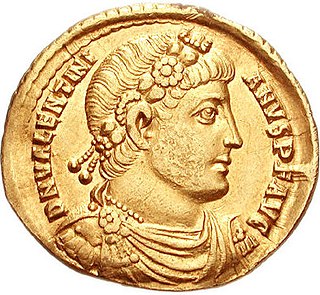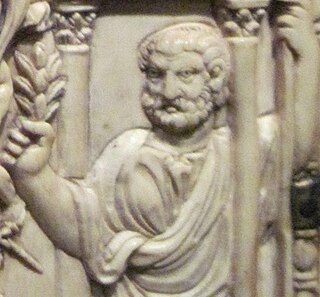Related Research Articles
Pope Pius I was the bishop of Rome from c. 140 to his death c. 154, according to the Annuario Pontificio. His dates are listed as 142 or 146 to 157 or 161, respectively. He is considered to have opposed both the Valentinians and Gnostics during his papacy. He is considered a saint by the Catholic Church and the Eastern Orthodox Church with a feast day in 11 July, but it is unclear if he died as a martyr.

A quaestor was a public official in Ancient Rome. The position served different functions depending on the period. In the Roman Kingdom, quaestores parricidii were appointed by the king to investigate and handle murders. In the Roman Republic, quaestors were elected officials who supervised the state treasury and conducted audits. It was the lowest ranking position in the cursus honorum. However, this means that in the political environment of Rome, it was quite common for many aspiring politicians to take the position of quaestor as an early rung on the political ladder. In the Roman Empire, the position, which was initially replaced by the praefectus (prefect), reemerged during the late empire as quaestor intra Palatium, a position appointed by the emperor to lead the imperial council and respond to petitioners.

Theodosius I, also called Theodosius the Great, was Roman emperor from 379 to 395. On accepting his elevation, he campaigned against Goths and other barbarians who had invaded the Empire. His resources were not sufficient to destroy them or drive them out, which had been Roman policy for centuries in dealing with invaders. By treaty, which followed his indecisive victory at the end of the Gothic War, they were established as foederati, autonomous allies of the Empire, south of the Danube, in Illyricum, within the Empire's borders. They were given lands and allowed to remain under their own leaders, not assimilated as had been normal Roman practice. Theodosius I was obliged to fight two destructive civil wars, successively defeating the usurpers Magnus Maximus in 387–388 and Eugenius in 394, at great cost to the power of the Empire. He is well known for effectively made the Nicene Christianity the official state church of the Roman Empire.

Flavius Valens was Roman emperor from 364 to 378, having been appointed co-augustus by his brother Valentinian I shortly after his own acclamation by the army. Valens ruled the eastern provinces of the Roman Empire.

Valentinian I, also known as Valentinian the Great, was Roman emperor from 364 to 375. Upon becoming emperor he made his brother Valens his co-emperor, giving him rule of the eastern provinces while Valentinian retained the west.

Valentinian II was Roman emperor from AD 375 to 392.
Flavius Theodosius, known as Count Theodosius or Theodosius the Elder, was a senior military officer serving Emperor Valentinian I and the Western Roman Empire. His son was the Emperor Theodosius I. He was granted the title of Comes Rei Militaris per Britanniarum by the Emperor Valentinian for his work there; putting down the Great Conspiracy (367–368). After restoring order in Britain he returned to mainland Europe and fought against the Alemanni; as Valentinian's Magister Equitum he successfully invaded Alamannic territory. In 372 Theodosius led a successful campaign against the Sarmatians. In the same year Firmus, a Mauritanian prince, rebelled against Roman rule. Theodosius was sent to Africa and in two hard-fought campaigns (373–374) put down the insurrection. In 376, after the death of emperor Valentinian, he was arrested and executed, presumably as he was seen as a threat to the new western emperors Gratian and Valentinian II.

Petronius Maximus was Roman emperor of the West for two and a half months in 455. A wealthy senator and a prominent aristocrat, he was instrumental in the murders of the Western Roman magister militum, Aëtius, and the Western Roman emperor, Valentinian III.
Valentinian may refer to:
Valentinus was the best known and, for a time, most successful early Christian gnostic theologian. He founded his school in Rome. According to Tertullian, Valentinus was a candidate for bishop but started his own group when another was chosen.

Quintus Aurelius Symmachus was a Roman statesman, orator, and man of letters. He held the offices of governor of proconsular Africa in 373, urban prefect of Rome in 384 and 385, and consul in 391. Symmachus sought to preserve the traditional religions of Rome at a time when the aristocracy was converting to Christianity, and led an unsuccessful delegation of protest against Gratian, when he ordered the Altar of Victory removed from the curia, the principal meeting place of the Roman Senate in the Forum Romanum. Two years later he made a famous appeal to Gratian's successor, Valentinian II, in a dispatch that was rebutted by Ambrose, the bishop of Milan. Symmachus's career was temporarily derailed when he supported the short-lived usurper Magnus Maximus, but he was rehabilitated and three years later appointed consul. After the death of Theodosius I, he became an ally of Stilicho, the guardian of emperor Honorius. In collaboration with Stilicho he was able to restore some of the legislative powers of the Senate. Much of his writing has survived: nine books of letters; a collection of Relationes or official dispatches; and fragments of various orations.

The Valentinianicdynasty or Valentinian dynasty, produced five Roman emperors during Late Antiquity, reigning over the Roman Empire from 364 to 392 and from 424 to 455. The dynasty's patriarch was Gratian the Elder, whose sons Valentinian I and Valens were both made Roman emperor in 364. Valentinian's two sons both became emperors, while his daughter married Theodosius the Great, producing a daughter that became an empress and whose son also became emperor. The dynasty of Valentinian succeeded the Constantinian dynasty and ruled concurrently with members of the Theodosian dynasty.
Justina was the second wife of the Roman Emperor Valentinian I and the mother of Valentinian II, Galla, Grata and Justa.
Arbogastes or Arbogast was a general of Frankish extraction in the Roman Empire's army.
Flavia Galla was an empress of the Roman Empire and a princess of the Western Roman Empire. She was the second empress consort of Theodosius I. She was the daughter of Valentinian I and his second wife Justina.

Religion in the Greco-Roman world at the time of the Constantinian shift mostly comprised three main currents:
Sextus Claudius Petronius Probus was a leading Roman aristocrat of the later 4th century AD, renowned for his wealth, power and social connections.
Vettius Agorius Praetextatus was a wealthy pagan aristocrat in the 4th-century Roman Empire, and a high priest in the cults of numerous gods. He served as the praetorian prefect at the court of Emperor Valentinian II in 384 until his death that same year.
The restoration and tolerance of Paganism from Julian until Valens, from 361 till 375 was a brief period of relative tolerance towards Pagans, preceded by the persecutions of Constantius II and followed by those of Emperor Gratian.
Flavius Claudius Antonius was a Roman politician under the reigns of Valentinian I, Gratian and Theodosius I. He was appointed consul in AD 382 alongside Flavius Afranius Syagrius.
References
| This ancient Roman biographical article is a stub. You can help Wikipedia by expanding it. |